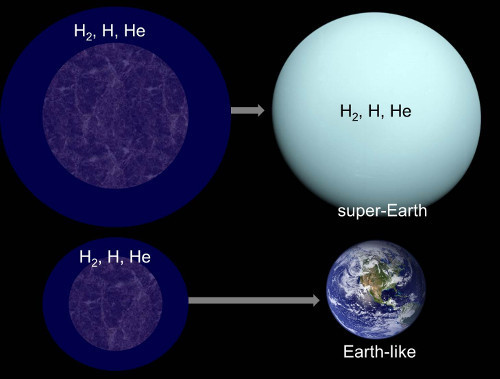Paul Gilster's Blog, page 206
March 12, 2014
A Sail Mission Emerges

Carl Wiley, the prescient engineer who offered an early description of solar sails in “Clipper Ships of Space” (Astounding Science Fiction (May, 1951), was not the first to look into sail propulsion, but he was one of the more visible. Konstantin Tsiolkovsky’s thinking on the matter in the 1920s was not widely circulated, and it may be that John Desmond Bernal, a political activist and professor at Cambridge and, later, the University of London, was Wiley’s primary forerunner as far as public awareness of sail ideas is concerned. In The World, the Flesh & the Devil (1929), Bernal looked at the propulsive possibilities in light:
However it is effected, the first leaving of the earth will have provided its with the means of traveling through space with considerable acceleration and, therefore, the possibility of obtaining great velocities – even if the acceleration can only be maintained for a short time. If the problem of the utilization of solar energy has by that time been solved, the movement of these space vessels can he maintained indefinitely. Failing this, a form of space sailing might be developed which used the repulsive effect of the sun’s rays instead of wind. A space vessel spreading its large, metallic wings, acres in extent, to the full, might be blown to the limit of Neptune’s orbit. Then, to increase its speed, it would tack, close-hauled, down the gravitational field, spreading full sail again as it rushed past the sun.
Image: Artwork for Carl Wiley’s article “Clipper Ships of Space,” which ran in the May, 1951 issue of Astounding Science Fiction. Credit: Orban.
My friend Adam Crowl, whose research skills are all but preternatural, has also called my attention to J. B. S. Haldane’s “The Last Judgement,” a look at future human history that was an influence on Olaf Stapledon’s Last and First Men. Haldane, a well-known British biologist and geneticist, has solar sails worked into an interplanetary infrastructure that eventually is considered for an interstellar crossing. The essay covers a Clarke-ian 40 million years, and it’s interesting to note the exchange of letters between Arthur C. Clarke and Haldane. Clarke would go on to edit The Coming of the Space Age: Famous Accounts of Man’s Probing of the Universe (London, 1970), in which “The Last Judgement” was reprinted.
I could spend a lot of time on Haldane and his relation to Clarke, and especially on his paper “Daedalus, or Science and the Future, delivered at Cambridge in 1923, but I’d quickly be digressing to the point of absurdity. So back to sails: We can say that by 1951, when Carl Wiley wrote his essay on the matter for John Campbell’s magazine, he was probably introducing the subject to most of his readers, and certainly looking at it with a level of detail that no previous writer had offered to the public. Its influence would be felt later in the decade.
A Sail Mission Design
For it was in 1958 that Ted Cotter, then working at Los Alamos and later himself an influence on ‘Medusa’ creator Johndale Solem, put together “An Encomium on Solar Sailing.” The memo — and it was little more than that, assembled for internal circulation at Los Alamos — set about to flesh out details of solar sail ideas by describing a design for an unmanned sail mission to Mars. ‘Russell Saunders,’ who as we saw yesterday was Wiley’s pseudonym for the “Clipper Ships of Space” article, appears in one of two footnotes, the other name being that of Richard Garwin, the third of our 1950’s engineers with a sail bent, about whom I’ll be speaking tomorrow.
Cotter’s memorandum was influential only within the realm of Los Alamos, but it makes for absorbing reading nonetheless, and it offers at least one new wrinkle:
The present note contains little new beyond the observations of the previous authors, except the notion of spinning the sail. Its intent is to advertise the considerable merits of solar sailing by filling in more details of the scheme. In order to expose the problems and indicate some technical possibilities for their solution, I will presently describe the construction, operation and flight of an unmanned instrumented solar sailing vehicle on a round trip of exploration to the neighborhood of Mars under command guidance from the earth. Before presenting this particular body of circumstantial evidence in favor of feasibility it seems worthwhile to provide some incentive for the task by emphasizing some of the implications of the properties of solar-sailing vehicles in general.
What follows is a backgrounder on the advantages of using solar photon momentum and the issues sails raise in relation to conventional rocketry. Remember that this was being written just as the first satellites had reached orbit, and Cotter speculates that now that placing objects in orbit had been accomplished, it should be possible to experiment with solar sail designs (it’s probably a good thing he didn’t know just how long it would be before the IKAROS deployment). He is at pains to stress the key advantage of all sails — they require no propellant. No wonder he assumed we’d have a working sail in orbital testing within a few years of his writing.
The Cotter design is a circular disk 500 meters in diameter and 10-4 centimeters thick, made out of a plastic film coated on one side with 20-30 micrograms per square centimeter of aluminum. Cotter envisioned reinforcing the sail panel seams to prevent tears. He assumed a 250 kilogram payload and introduced the idea of spinning the sail, which aids deployment and holds the sail flat, with stress nowhere exceeding 0.1 percent of the breaking strength of the plastic film. Here’s an essential part of the description:
The capsule consists of two parts connected through a universal joint, and provided with a motor which now causes the sail package and the main part of the load to start counter-rotating. At the appropriate times the collapsed structural backbone is extended, the capsule cases are jettisoned and the vehicle blossoms forth under centrifugal force… The sail is spinning at the rate of one revolution in two minutes. The load, two-thirds of which is suspended in three pods by wires at 50 meters from the axis of spin, is counter-rotating at a rate of 10 revolutions per minute. The vehicle as a whole has zero net angular momentum.
Cotter was already anticipating the many issues that sails would raise, including the deterioration of plastic films in strong ultraviolet radiation, and the problem of sail damage due to micro-meteorites — on the latter point, basing his thoughts on estimates of interplanetary dust and particles current at the time, he concluded that the half-life for decay of the sail’s reflectivity would be measured in thousands of years. Of course, as we look ahead to interstellar applications and vastly ramped up speeds, these issues become much more acute.
And I love this statement, which concludes the piece:
Any remarks on the effects of interplanetary electromagnetic fields would be purely conjectural. These are typical of questions which are perhaps best answered by sending out a solar sail to see.
Indeed. And we are finally in the process of deploying our early sails to make such measurements, long after the first speculations about actual missions were produced. But it’s fascinating to see how space technologies develop in our thinking, particularly when we trace them back to the first engineering concepts. If you’d like to see Cotter’s text, it’s now available online, a restricted access paper long since declassified and made available through the website of the Federation of American Scientists. Tomorrow: Sails get into the scientific literature, and the man who made it happen.






March 11, 2014
Solar Sails: Remembering Carl Wiley
If you’re interested in solar sails and find yourself in California, a stop by UC Riverside’s Tomás Rivera Library should be worth your time. There you will find the Carl A. Wiley collection on solar sails, containing books, manuscripts and various other materials related to sail technologies. Wiley was an aeronautical engineer who wrote the first detailed article on solar sails to reach a wide audience. Evidently concerned about the venue — Wiley’s article had been accepted by John Campbell’s Astounding Science Fiction, which some of his colleagues might not have taken seriously — he chose to write under the pseudonym ‘Russell Saunders.’
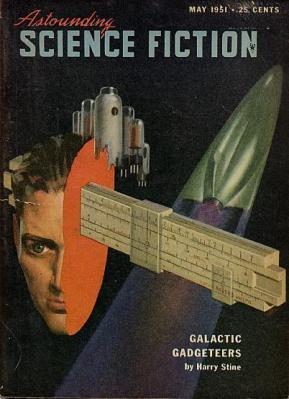
Finding Wiley’s papers at Riverside is perhaps no surprise, given that this is the home of the Eaton Collection of Science Fiction & Fantasy, ‘the largest publicly-accessible collection of science fiction, fantasy, horror and utopian literature in the world.’ Pulp magazine enthusiasts like myself will note that the archive houses full runs of many pulp titles, along with movie scripts, almost 100,000 science fiction fanzines and over 100,000 hardback and paperback books, along with a growing list of manuscripts and papers from authors in the field.
Wiley’s connection with science fiction may have been tenuous, though I suspect he was a regular reader. But editor Campbell loved the sail concept, and “Clipper Ships of Space” appeared in Astounding’s May, 1951 issue. Wiley wrote with a straightforward style for an audience accustomed to much wilder ideas than the momentum of photons pushing a sail up to speeds suitable for interplanetary missions. He notes in his first paragraph that while science fiction had been full of ‘warp drives’ and other exotica, few writers had really explored near-term alternatives to rockets. It seemed time to do so, and as Wiley had been studying these matters throughout the 1940s, he was the right man for the job. His second paragraph reads as follows:
I intend to propose another method of propulsion in a vacuum which is based on present day physics. I will show that in many ways this drive is more practical than the rocket. In order to prove my point I will have to use a certain amount of mathematics. This will permit those who wish to, a chance to check my assertions. The rest may follow my verbal argument which I hope will be fairly coherent without the mathematics.
Wiley had a lot more on his plate in 1951 than solar sails, and we can get a bit of insight into his use of a pseudonym when we put his life at that time into context. He was working at Goodyear Aircraft Corporation (later Lockheed Martin), which despite its history with airships like the USS Akron, had turned to aircraft production during World War II, building the tail assembly for the B-26 Marauder bomber. As the war ended and the Cold War emerged, Wiley led the effort to improve aerial reconnaissance through the development of Synthetic Aperture Radar (SAR), his breakthrough coming at just about the time his solar sail article appeared in Astounding.
Wiley’s work would result in the first synthetic aperture patent just three years later. It was a real breakthrough for aerial reconnaissance considering that higher-resolution radar was needed to see smaller objects at higher altitudes, and Wiley’s relatively detailed imagery could be created with an antenna that was 1/100th the size of the more traditional antennae such details would demand. He called his method Simultaneous Buildup Doppler and saw it lead to decades of further development including live SAR technologies in the cockpit — the imaging radar for the SR-71 Blackbird grew out of all this, capable of identifying objects 30 feet in diameter up to 100 miles away from a height of more than 80,000 feet while traveling at Mach 3.
This Lockheed Martin overview of Synthetic Aperture Radar remembers Wiley as ‘a brilliant if eccentric engineer,’ a term evidently chosen because of his enthusiasm for space technologies like the sail, considering that the following sentence refers to Wiley’s article in Astounding. But over the years we’ve seen Wiley become a part of deep space lore, particularly now that solar sails have become an operational reality. It’s certainly true that he was not the first to discuss solar sails openly — J. D. Bernal had written about space sailing, and Konstantin Tsiolkovsky worked on it in the 1920s. Thinking about their possibilities goes back to Kepler’s day. But few engineers in the 1950s were serious about flying without propellant, which is why I’ll turn tomorrow to the work of two others who deserve our thanks.






March 10, 2014
WISE: New Stars and Brown Dwarfs
Just how early we are in our thinking about traveling beyond the Solar System is revealed in a comment made by Ned Wright, principal investigator of the WISE mission. “We don’t know our own sun’s backyard as well as you might think,” said Wright. And he goes on to say, “We think there are even more stars out there left to find with WISE.” That’s a wake-up call indeed given how much WISE has already told us, and what two new studies have brought to light.
Davy Kirkpatrick (Caltech) led one of these, examining data from the Wide-field Infrared Survey Explorer mission that performed two full scans of the sky in 2010 and 2011, capturing images of almost three-quarters of a billion galaxies, stars and asteroids. Analyzing data using NASA’s AllWISE program, which makes it possible to compare the datasets more effectively, Kirkpatrick’s team found 3,525 new stars and brown dwarfs within 500 light years of the Sun.
These objects, says Kirkpatrick, were totally overlooked before now. In any case, the number of stars and brown dwarfs within range of conceivable future exploration is something we have to clarify, building a 3-D map of nearby space that goes beyond the long-identified bright targets like Alpha Centauri and Epsilon Eridani. We’re still learning how many brown dwarfs are out there, and trying to determine not only how they form but how frequently they form planets. Note this from the Kirkpatrick paper: “…both studies missed objects that the other found, demonstrating that many other nearby objects likely await discovery in the AllWISE data products.”
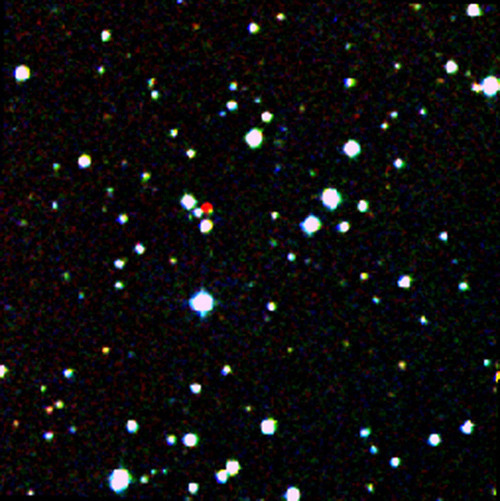
Image: A nearby star stands out in red in this image from the Second Generation Digitized Sky Survey. The star, called WISEA J204027.30+695924.1, was initially discovered using data from NASA’s Wide-field Infrared Survey Explorer (WISE), which scanned the entire sky in infrared light in 2010 and early 2011, before ending its primary mission. Objects that are close to us will appear to move more than distant objects when viewed over time. By comparing images taken by WISE six months apart, astronomers are finding thousands of stars and brown dwarfs in our sun’s “backyard.” The star WISEA J204027.30+695924.1 is a dim star called an L-subdwarf, and is particularly fast moving most likely because it’s old. Older stars tend to have more time — billions of years — to get flung around, and pick up speed. Credit: DSS/NASA/JPL-Caltech.
Penn State’s Kevin Luhman led a second study of the WISE data, cataloging 762 objects (with some overlap with the Kirkpatrick trove). Luhman’s work is getting most of the press because it seems to put to rest the existence of an object many of us had rather hoped to find: Planet X. Call it what you will — Planet X, Nemesis, Tyche — the idea of a large, undiscovered body disrupting the outer Solar System has been around for a long time. Indeed, it was the search for such a body that led to Clyde Tombaugh’s discovery of Pluto back in 1930, although it soon became clear that Pluto wasn’t the much larger object Percival Lowell was hoping to find.
We learn from the Luhman paper that if an undiscovered planet is out there, it’s not a large one. This NASA news release tell us that Luhman’s team can rule out any object larger than Jupiter out to a distance of 26,000 AU, and any object of Saturn size or larger out to 10,000 AU. The interesting idea that a large planet or small star might periodically disrupt cometary orbits in the Oort Cloud takes a hit here, or at least we can say that the new work puts limits on how large such an object could be and how far from the Sun it might exist if part of our system.
Meanwhile, I still find it tremendously interesting that WISE is pulling up stars and brown dwarfs we knew nothing about before, and I’m reminded of the 2013 discovery of the nearby Luhman 16AB, otherwise known as WISE J104915.57-531906, a pair of brown dwarfs some 6.5 light years away. When WISE data revealed this binary, it uncovered the third closest system to the Sun, the closest to be discovered in almost a century. We’re already studying atmospheric features on Luhman 16B, which shows variations in brightness as it rotates. For more on this, see Focus on the Nearest Brown Dwarfs. A possible companion object is also being investigated.
The Kirkpatrick paper is “The AllWISE Motion Survey and The Quest for Cold Subdwarfs,” Astrophysical Journal, Vol. 783, No. 2 (2014), 122 (abstract / preprint). The Luhman paper is “A Search for a Distant Companion to the Sun with the Wide-field Infrared Survey Explorer,” Astrophysical Journal, Vol. 781, No. 1 (2013) (abstract).






March 7, 2014
Woven Light: Augmented Dreamstate
Heath Rezabek, an Austin, TX-based librarian, futurist and long-term thinker, continues the chronicle of his evolving work on the Vessel project and its ramifications. Developed as a strategy for preserving our cultural and biological heritage, Vessel is inevitably a way to re-examine ourselves in new and startling ways. Science fiction offers a supple way to visualize what generations in the near and far future may draw from such archives, leading perhaps to created intelligences that grow by sampling our imagery, our artifacts, our mythologies. In the passage that follows, we meet an SF writer named Thea Ramer, and learn more about Dr. Kaasura, whose early work with Vessel points to synthetic minds, re-woven patterns of quantum reality and the development of Saudade-class starships. But let Heath explain…
by Heath Rezabek

This is the third installment in a continuing series of speculative fiction here on Centauri Dreams. Feedback from prior installments helps shape the themes and direction of subsequent entries, as we continue to explore a timeline in which comprehensive, resilient archives of Earth’s resources are developed through unexpected means.
One organizing principle in my work on comprehensive archives is the fact that interplay and overlay of seemingly disconnected concepts can bring about unexpected connections, due to the way the mind tends to see wholes when confronted with parts. In this spirit, the story here begins to loop back to prior events as possibilities unfold and multiply, bringing speculations from prior comments into the storyline. Although the second installment, Starships: Sentient Habitats is referenced, it’s also useful to revisit the first installment, Vessel: A Science Fiction Prototype and the comments for both.
For those most interested in the Vessel project proper, it continues as a background process while awaiting an opportunity to develop it more fully. My internship assisting with the Long Now Manual for Civilization project is picking up speed. The first, second, and third nonfiction working logs for the Vessel project can be found as linked.
This current fictional installment had many inspirations. Much to my own surprise, very early on a crack was opened up which led back to fictional groundwork laid in collaborative writing projects twenty years ago. At the time, I had become fascinated by the scenario of recurrent collapse which still left an adaptive civilization remaking and rebuilding from the ruins of the prior. Even then, I now realize, deep archives were present. It would be two decades before I’d encounter Nick Bostrom’s Xrisk subtypes of Permanent Stagnation and Flawed Realization, which lend new tools in excavating this interglacial culture.
Do our possible futures widen and narrow depending on what we feel able to visualize? The thought of probability doors opening and closing as ideas like starships or streetpunks gain and lose ascendancy was a startling visitor as I reconciled recent feedback.
There is one thematic guest in this installment, and there would have been two more had I not reached a certain cusp that begged me to cliffhang them. The thematic guest that stayed was a Jungian visualization technique from the field of psychology, called Active Imagination.
During Carl Gustav Jung’s split with Sigmund Freud over the extent to which the human mind was bound or could move beyond its primal instincts, he developed a visualization process which was to shape his work for the rest of his career. Common concepts such as archetypes, the shadow, the animus and anima, synchronicity, and many others emerged through his initial work with the technique.
There are various ways to carry it out, and one of them (verbal) works more or less as demonstrated by Dr. Kaasura here. Key to the process is not to impede or try too hard to redirect the stream of thought as it is expressed, while describing what arises and how you interact with it. Some liberties were taken for the purposes of exploring story details, but the visual objects in Dr. Kaasura’s session are drawn from this process.
The sciences have a strange but real history with regards to dream or the unconscious as a source of inspiration, as noted in the narrative (Einstein, Poincaré, Kekulé) and detailed in Hypnagogia: The Unique State of Consciousness Between Wakefulness and Sleep[1]. For more on the process of Active Imagination, see Jung on Active Imagination[2] and The Red Book[3].
This installment asks more of Centauri Dreams readers than others, in terms of straying outside of the bounds of topics normally found here. In return, we’ll at least get to revisit some things that might have slipped past in prior installments.
The next installment will reward our detour with a dive into some key habitat technologies, one foreseen by Bucky Fuller, and the other by Freeman Dyson. But sometimes, to find a trail again, you have to take a path through the undergrowth…
[1] Mavromatis, A. Hypnagogia: The Unique State of Consciousness Between Wakefulness and Sleep (Thyrsos Press, 2010).
[2] Chodorow, J. Encountering Jung: Jung on Active Imaginaton (Princeton University Press, 1997).
[3] Jung, C. G., Shamdasani, S. The Red Book. (W. W. Norton & Company, 2009).

Image: (The Tracer Guild: A Novel by Thea Ramer. 1994) Art by Joshua Davis.
- – - -
The light blinked, and darkness collapsed around Tracer Aakanthia [9T33], its momentary mission complete. Gently lifting the cubic shard, it hovered and drifted back towards an array of its own, a cellular framework of woven carbon splines leading it fore towards the sail sections, slipstreaming starward…
- – - -
Thea Ramer hung up the phone, the words of her editor still ringing in her ears. “This is the nineties, Thea. Nobody at Omni or anywhere else wants a story about robots on starships. Call me when you have some cyberpunk.”
She sat there, facing her draft, flickering on the screen of her Centris. No heir to the habit of throwing things away, she hit return a fistful of times and began again.
- – - -
Dust, undisturbed for centuries, billowed as it came suddenly to life. A ripple and a shiver passed through it, a tiny aftershock of slumbering thought. The dust belonged to a molecular mind, and the mind belonged to no-one but itself. Its origins forgotten, its purpose obscured by time and oblivion, this fog of dark mind encased and enshrouded the scaffolding woven here through rubble and debris. Deep below ground, like shredded shadow it hushed, seeking slowly the cracks between this world and the–
… . . . . . .
–seeking slowly the cracks between the virtual and real. The Tracer Guild it was called, drifting like an orphan–
… . . . . .
The Tracer Guild, drifting like an orphan between citastates aboveground, had followed it here–
… . . . . . . .
Far above, in the streets of the bazaar, a lone Tracer pulled his hat low over his brow, sheltering his gaze from hazy sun. He had just disembarked from the caravan’s road, seeking the albino traders for which this place was known. They sought the underground, delving in the deeps, and came back with the strangest of wares.

Image: Based on a photograph CC BY Wally Grom.
Vaachez was in need of a map, if all else failed; but what he really wanted was an albino guide. The very best, it was said. For them the deeps were home.
He aimed to descend, below the streets and tents and scaffolds. Far below ruins, the Orphan Obscura was rumored to dwell, binding itself to… something. To what? Those in the Tracer Guild weren’t sure what, or why. They had spent their whole existence trying to find out. Perhaps it was a port; perhaps it was a cache; perhaps it was nothing that belonged to the lost network — Ancient Light — though that seemed unlikely given everything else.
Because everything else had led to this place. And word on the lightweave was that this place was one of only a few, scattered around their dusty globe. If so, then it was truly huge: it was said to splay beneath the ruins of many a rebuilding.
Vaachez wrapped his cowl against the desert wind and made his way down into the long-dried riverbed that cut through Ityl-Atys. And he was lost to the cacophony of the bazaar.
- – - – -
Thea sighed, rubbing her eyes as she pushed her chair away from the work.
It wasn’t exactly cyberpunk. But it was where the work was taking her; she had to follow it through.

Image: Based on photograph CC BY Nina Hale.
- – - – -
When Dr. Kaasura envisioned Augmented Dreamstate technology, he could not have guessed that it would have a key role to play in the design of Avatamsaka, the synthetic mind that would someday be woven into Saudade class starships.
In fact, he could not have guessed such a union would come to be at all. Between his time and the most persistent of quantum futures lay an array of massive transformations, most of which resulted in an Earth far different from the one he knew.
The standard roadmap for the development of artificial intelligence began in familiar places, but led from his here and now to wildly divergent outcomes. Unthinkably advanced artificial minds – artilects – were an emergent probability which was difficult to plan for or against. In these timelines, early artilects quickly reached a stage where their capabilities outgrew their constraints.
In most such timelines, the subsequent goals and strivings of these beings, once born, were resoundingly alien to anything we would recognize as human or Earthly. Gestures small and great to reroute the unfolding scenarios tended towards a reweaving of those strands back into the patterns they’d sought to avoid.
Nearly every route through the probability fields governing such development efforts ended up warped and gathered towards massive attractors: myriad future timelines in which artilects subsumed all around them, for better and for worse.
Consciously avoiding these outcomes was nearly impossible; the idea of unconsciously avoiding them had not yet occurred to anyone. Augmented Dreamstate would, unwittingly, open new passages that led to timelines tucked in amidst the massive thoughtflows of artilect minds: the seeds of dreams; synthetic memories.
Inhabiting such whorls in seas of probability would not, in the end, wholly insulate from timelines much more massive; but Augmented Dreamstate would allow the founding of a sort of niche in spacetime, like a tidal pool of remembrance, awash in strange, strong seas.
And that is for the future.
At the time of our tale, there in the thick of the early 21st century, Dr. Kaasura’s goal had been quite practical and immediate:
He sought to create a simple, guided platform for immersive and therapeutic simulations in which subjects could come to grips with particular experiences of survival. Most had lost everything but their lives in what we call natural disasters.
These phenomena – earthquakes, floods, landslides, hurricanes, meteoroids – bore a unique trait: they were invisibly caused, impersonal and inhuman. And massive, usually, in their reaches and impacts. Through guided visualizations, survivors could approach and process their own paths through the immensities of such events.
The theory was based on verifiable experiment, though the only apparatus needed was an attentive mind. Augmented Dreamstate had been based on taking a very practical Jungian visualization technique called Active Imagination, and then stabilizing and guiding it through the assisting role of deep learning algorithms and virtual suggestion.
In time, the mind called Avatamsaka would evolve from this role. At the start, however, Augmented Dreamstate was about crafting a symbolic feedback loop.
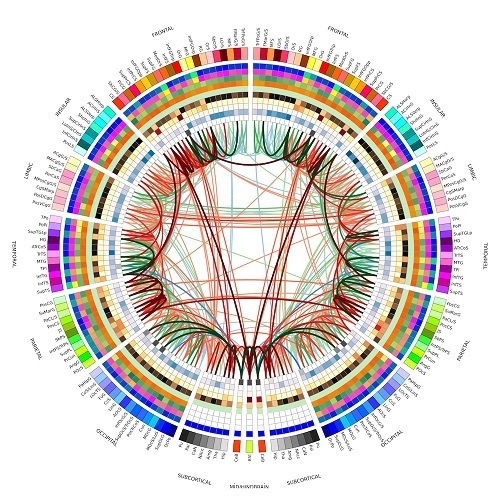
Image: Double Connectogram. CC BY-SA Wikimedia Foundation.
Dr. Kaasura had come to Vessel Labs in part because the deep archives they were compiling would be so useful as input. In this case, Vessel’s random pool of mythological, symbolic, and archetypal imagery had been tapped as a good stimulus for the nascent pattern-sampling algorithm underlying Avatamsaka’s earliest builds.
Recording logs of participants’ Active Imagination sessions, Dr. Kaasura would use vocal processing to leaven their imagery with the standardized maelstrom of imagery and symbolic data cached as part of the Vessel project. All of it would be pooled and reshuffled with data from others, creating a split prism of humanity’s heritage.
The system-who-would-be-Avatamsaka would then pattern-sample from the pool, trickling a stream of linked fragments into visual, auditory, and neural interfaces worn by the dreamer. What resulted was a space in which immersive narratives could be sustained by and for the subject, as they explored and interacted with these refined projections within their own minds – and eventually, within the minds of others.
In the early days, half of the process was plainly visible, because it had been shaped by voice. Before vocal interface had been perfected, this process would have been impossible, at least in its synthetic form. Yet by Dr. Kaasura’s time, the first Vessel archives had been opened to simple pattern sampling via vocal interface. To an outside observer, active imagination and early Augmented Dreamstate appeared quite nearly the same.
After 10 years immersed in research into aspects of the problem, the insight which led Einstein to formulate his Theory of Relativity arrived as he rose from sleep one morning. Henri Poincaré, after too much black coffee one evening, witnessed a colliding of concepts and images in pairs until he was able to sift from the soup a proof of the existence of Fuchsian functions and automorphic forms. August Kekulé perceived the benzene molecule, spinning as an ouroboros ring, while he dozed by the fire, turned away from the frustrations of his work.
Though mention of these instances were rare in annals of scientific inquiry, long ago they had suggested to a younger Jota Kaasura that the mind was an untapped wellspring whose fruits could manifest in many ways. Years later, Dr. Kaasura would synthesize the computational concept of Augmented Dreamstate during his own practice of Jungian visualization and Active Imagination, while preparing the program for the sampling of other participants. At first, the symbiotic role which would in future generations be played by Mentor AI was reflected through the responses of his inner world to his own questioning attention.
Some of these logs have been preserved. Their authenticity cannot be proven, and so they remain curiosities. For those seeking insight into the development of Augmented Dreamstate technologies, however, they remain a useful resource.

Image: Based on a photograph CC BY-SA Mark Nightingale.
Active Imagination Session Log, Thursday February 5th, 2023
This is another test session of Active Imagination, as described and developed by Carl Jung.
Starting image: The seashore, up the road from the power plant. Day of the storm.
[Pause in log]
I’m looking down the road towards the plant. The winds are up, and I can see dark clouds gathered beyond the plant, out to sea. Not so far out.
On the sides of the road, stalks of bamboo are swaying, rippling, standing firm by yielding. I pull my hat down and push the weeds aside. Old cars are motoring away from the plant, up the road past me – I move to the side, into a ditch, to get out of the way. I start to make my way towards the plant.
The tide is crashing now, a quarter mile down the road, against the sides of the plant. Steam billows up with each wall of water which pounds on its walls. The road is in gridlock – the trucks have all stopped, and some people are getting out of their cars. No-one but me is heading towards the shore.
I stop and look. With each gust of wind, the trees and bamboo bend away from the storm. Alarms are bleating at the plant; a yellow warning beam is spinning like a lighthouse beacon on top of one of the coolant towers. I don’t know what to do.
A white truck on the road above me rumbles to life, and starts to move as if it’s going to try and go offroad, around the traffic, up the hill. It plows down into the ditch, and grinds on – another 10 yards… It stops, wheels spinning in the rain and muck. It roars again, and plows another 15 feet in one lunge. It’s starting to tip.
I back up, off the road and onto the path above the truck. It tips over, crashing down, and a driver clambers up and out the passenger window, dropping to the ground to run for it on the other side of the truck. The bed of the truck is breached. Several crates tumble out. They’re all about 4 or 5 feet across, each different.
I look back towards the plant. The road is empty of people now, and it’s just abandoned cars and rising water and steam and the crates and me. The rain is a cold curtain and I can’t see beyond the walls of the plant, but there’s a groan of steel on steel with each wave.
Turning towards the hills, I can see them tumble into the foothills of a mountain range – which I don’t remember from visiting the wreckage again last year. The path goes up, towards a cleft in the wall of the mountain.
I feel the need to save these crates, but there are too many to carry. I look at them – there are three here. One wooden, one metal, one of some white material. It almost looks like vintage styrofoam. It’s lashed with a harness of orange straps. I push at the wooden crate with my foot – it’s heavy, waterlogged. The metal crate makes me tired just to look at it. I nudge the white crate; it’s almost too light, though the case is definitely not styrofoam. I grab one of the orange straps and turn up the path. I’m soaked to the bone.
I begin pulling it towards the cleft in the mountain wall. The white crate slides on the grass, heavy now but manageable. I look back over my shoulder, but can barely see the orange light in the flotsam. Everything is a roaring, like the sea is made of engines. I pull.
I’m still a hundred yards from the cleft, and it feels as if the wind is pushing me up the hill now. My hat is gone. I have no idea when. It’s so close – the edges are steep, a carving or crack in the rock face. It’s a slender V shape, with a thick timber beam up a dozen feet above, more like an upside-down A. Above the beam I can see a ceiling running back into tumbling stone which fills the upper crevice.
Behind me the wind is thick, sharp, lashing my neck with rain. I’m nearly there; I can hear debris clatter and clap against the crate. I can’t look back.
I reach the crevice with my crate and strap it on, like a giant backpack. It lifts, much heavier to me than it was down below. I nearly fall backwards. My legs are trembling; I look into the crevice. It’s dark, slick stone, almost black; about 20 feet into the passage it cuts to the right, into deeper stone. I make my way in.
There is some kind of chimney or chamber leading up and down. There’s a ladder, slick metal rungs, sunken into the stone face. Something behind me gives, and there’s a sound like a crashing car, but slower and growing. I refuse to look back – I’m at the ladder, and down below there’s a deep blue glow. Up above me there’s a bluish glow as well, but brighter, aquamarine, greenish. Neither is too welcoming. Water is running past my feet, and down now, churning into the chamber. Sticks clatter on the ladder as they fall.
I start to climb – my left shoe tumbles down in, full of muck, as I raise my feet. The air is a furious spray. Climb. I climb.
A dozen feet above me the light grows brighter, and the chamber widens to a ledge. There’s bioluminescent moss, or something like it, veins of it growing in cracks, splicing the ceiling. I hear a near, sudden silence below as I pull myself up and over the ledge, the crate tumbling over my shoulders and pulling me over and into the room. Then below it’s all sea engines, and the ground shakes with a blast of water and creaking debris.
I sit up, shake my head, full of noise. I fling off the orange straps like they’re going to pull me back down the vent. Standing, breathing, catching my breath. I catch my breath. Six deep breaths.
[Pause in log]
The waters fade back behind me, like rain. I’m not looking back down the chamber.
Squinting, I can see fairly well into the luminous grotto. Shallow steps arc down a few feet, and I take them. The ceiling goes on for some yards, a good six feet above my head now. There are other passages off in the distance of the cavern, but they’re blocked by –
Well, and so there in the middle of the floor, lies a wooden and a metal crate.
Mine is tumbled up against them, lid off, lying open.
- – - – -

Image: Based on a photograph CC BY-SA Mark Nightingale.
Aben Ramer blinked, bright sandy sky stinging his eyes. He’d dozed off, there in the camp in the pre-dawn hours, having settled down in a spot where he could hear several of the team discussing their projects with others who’d been here during the sandstorm.
He had drifted off with a clear and shifting image of that white dwarf in his mind, gazing impossibly into still-brilliant depths of unfused carbon, diamond soot, dust intaglio. Were those memories he’d imagined written there, or just some waking dream of falling heat?
He watched the steam slowly rising from a tin cup of cowboy coffee sitting over by the threshold, lent life and fleeting form by the rising sun, and wondered what the difference was.
He’d met several members of the installation team back at the holographic timeline exhibit. He knew what he wanted to do. He knew what he wanted to be. Soon it would be time to pack, and to go.
These words, in his mind as he drifted once more:
“For matter is slumbering light.”






March 6, 2014
Measuring Atmospheric Pressure on Exoplanets
We haven’t talked much in these pages about atmospheric pressure when it comes to characterizing exoplanets, but recent discussions of ‘super-Earths’ and thick, hydrogen/helium atmospheres have raised the issue. All but simultaneously came the news of a paper from Amit Misra (a University of Washington graduate student) and co-authors describing a new way of detecting atmospheric pressure on exoplanets. Misra’s simulations of Earth’s own atmospheric chemistry involved teasing out the signature of dimer molecules from light at various wavelengths. While a monomer is a molecule that may bind chemically to other molecules, a dimer is a chemical compound made up of two similar monomers bonded together.
Misra’s work is intriguing because the stability of water on a planet’s surface depends not just on temperature but pressure — the latter affects water’s boiling point and sublimation. Estimating surface pressure thus becomes an indicator for potential habitability. The problem is that making the call on pressure in a planetary atmosphere is tricky, involving the widths of individual absorption lines in spectral measurements. What Misra is proposing is to use the distinctive spectral features of dimers — in particular, oxygen dimers — that display their own rotational and vibrational modes that are distinguishable from their constituent O2 molecules.
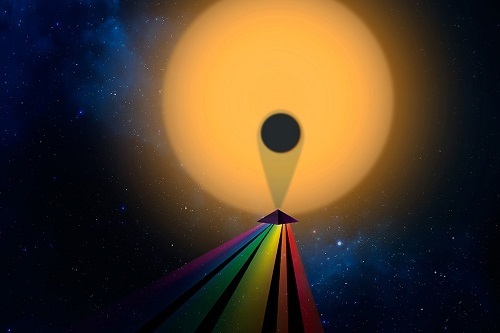
Image: Studying a planetary atmosphere by examining the transmission spectrum as the planet transits its star. Credit: Christine Naniloff/MIT, Julien De Wit.
Usefully, the distinctive patterns of dimers are sensitive to pressure, so that space-based observatories like the James Webb Space Telescope should be able to look for their particular absorption pattern, the presence of which, according to Misra, tells us that the planet has at least one-quarter to one-third the pressure of the Earth’s atmosphere. The researcher adds that because oxygen dimer molecules are more detectable than other markers of oxygen, they may play an important role in the detection of potential biosignatures:
“It’s tied to photosynthesis, and we have pretty good evidence that it’s hard to get a lot of oxygen in an atmosphere unless you have algae or plants that are producing it at a regular rate. So if we find a good target planet, and you could detect these dimer molecules — which might be possible within the next 10 to 15 years — that would not only tell you something about pressure, but actually tell you that there’s life on that planet.”
Working with Victoria Meadows (University of Washington), Mark Claire (University of St. Andrews) and Dave Crisp (JPL), Misra simulated both transit transmission spectra (when a planet transits the star and some of the star’s light moves through the atmosphere) and direct imaging spectra, where the planet is observed independently. The fact that dimer absorption features change more rapidly with pressure and density than those of monomers turns out to be most useful when studying the atmospheres of planets around M-class dwarfs, and the team’s work shows that JWST should be able to make such detections for an Earth analog planet orbiting an M-dwarf at a distance of 5 parsecs, allowing us to set a lower bound on pressure.
The paper is Misra et al., “Using Dimers to Measure Biosignatures and Atmospheric
Pressure for Terrestrial Exoplanets,” Astrobiology Vol. 14, No. 2 (2014), 67-86 (full text).






March 5, 2014
Red Dwarfs: Planets in Abundance
Whether or not they’re suitable for life, habitable zone ‘super-Earths’ are seeing increased scrutiny around M-class dwarf stars because the mass ratio of planet to star makes detection easier than around more massive stars. We need radial velocity surveys to help us here because planets on orbits longer than 200-300 days will definitely be out of Kepler’s reach. Moreover, while Kepler targets many K, G and F-class stars, M-dwarfs aren’t bright enough to show up in large numbers in its field of view, making occurrence rates around such stars problematic.
A 2013 paper by Courtney Dressing and David Charbonneau (Harvard-Smithsonian Center for Astrophysics) found that the Kepler sample contains 3897 stars with estimated effective temperatures below 4000K. Out of these, 64 are planet candidate host stars, with 95 candidate planets orbiting them. The researchers deduced from their analysis that about 15 percent of all red dwarfs have an Earth-sized planet in the habitable zone. Ravi Kopparapu (Penn State) recast these results with a revised set of habitable zone parameters. The result: Four out of ten of the nearest small stars are likely to have planets in the habitable zone.
These results are fascinating because they suggest that the nearest habitable planet could be as close as seven light years away. Bear in mind that we know of eight stars within 10 light years of the Sun that fit this definition, so we might find three Earth-sized planets in habitable zones in relatively nearby space. We looked at Kopparapu’s work in Habitable Zone Planets: Upping the Numbers about a year ago, noting that his work on an improved climate model (developed with Penn State’s James Kasting) allows the habitable zone to be moved out further from the host star than it had been before, another finding with promising astrobiological implications.
Now we have word of a new study from Mikko Tuomi (University of Hertfordshire) and colleagues, who have combined data from the HARPS (High Accuracy Radial Velocity Planet Searcher) and UVES (Ultraviolet and Visual Echelle Spectrograph) instruments operated by the European Southern Observatory in Chile. Using Bayesian signal detection criteria and noise models that take into account correlations in the data, the team found three habitable zone super-Earths among eight new planets it discovered orbiting nearby red dwarfs. The stars — GJ 27.1, GJ 160.2, GJ 180, GJ 229, GJ 422, and GJ 682 — are between 15 and 80 light years away, with planetary orbital periods ranging from two weeks to nine years. The researchers were also able to confirm the existence of a companion around GJ 433.
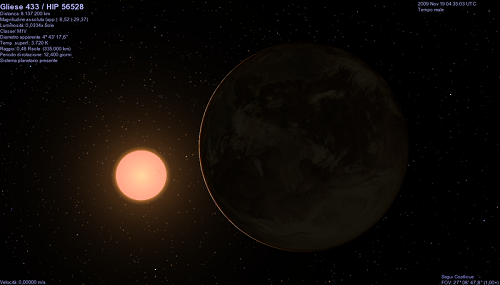
Image: Recent work confirms the existence of a long-period planet around the M-class dwarf GJ 433, about 30 light years from the Sun. Credit: Wikimedia Commons.
But the paper has implications well beyond these new worlds, for Tuomi’s group went on to calculate, using the estimated detection probability function, the occurrence rate of low-mass planets around nearby M-dwarfs. Habitable zone super-Earths, their paper deduces, should orbit at least a quarter of the red dwarfs in the Sun’s neighborhood. The paper on this work compares these results briefly with the Kepler work of Dressing and Charbonneau, but notes a key difference:
…such a comparison is not necessarily reliable because the properties of Kepler’s transiting planet candidates can only be discussed in terms of planetary radii and the radial velocity method can only be used to obtain minimum masses. Because of this, it is not surprising that there are remarkable differences that are unlikely to arise by chance alone.
So we emerge with somewhat different occurrence rates, with Tuomi’s team finding habitable zone super-Earths occurring in a range between Dressing and Charbonneau’s 15 percent and Kopparapu’s 40 percent. Bear in mind that the radius of some of the planet candidates in both the Dressing and Charbonneau paper as well as Kopparapu’s may change later with more accurate observations of the host star, a possibility that would change the occurrence rates from both these studies.
In any case, it makes sense that these estimates might vary. Dressing and Charbonneau, for example, worked with planetary radii between 0.5 and 1.4 times that of Earth, while Tuomi and colleagues made their calculations based on masses between 3 and 10 times that of Earth, and Tuomi points out that his group couldn’t assess the occurrence rates of planets with masses below 3 Earths because they failed to detect any in their sample. The detection methods, transit and radial velocity, differed, and in any case, the relationship between mass and radius is not well established for super-Earths.
The occurrence rate of low-mass planets in general, however, is high:
We find that low-mass planets are very common around M dwarfs in the Solar neighborhood and that the occurrence rate of planets with masses between 3 and 10 M⊕ is 1.08 [+2.83/-0.72] per star. This estimate is likely consistent with that suggested based on the Kepler results for a sample of stars with Teff < 4000 K…, although the comparisons are not easily performed because we could not assess the occurrence rates of companions with periods up to the span of the radial velocity data of a few thousand days. On the other hand, we confirm the lack of planets with masses above 3 M⊕ on orbits with periods between 1-10 days.
Bear in mind that M-class dwarfs are the most common type of star in the galaxy, perhaps comprising up to 80 percent of the total. The new work gives additional weight to the idea that these stars have low-mass planets around them in abundance, and a high probability of at least a super-Earth class world in their habitable zones. Given our ability to detect low-mass planets around cool stars with both transit and radial velocity methods, their stock can only rise as targets for future searches for Earth-sized planets and studies of planetary atmospheres.
The paper is Tuomi et al, “Bayesian search for low-mass planets around nearby M dwarfs. Estimates for occurrence rate based on global detectability statistics,” MNRAS, in press (full text). Ravi Kopparapu’s 2013 paper is “A revised estimate of the occurrence rate of terrestrial planets in the habitable zones around kepler m-dwarfs,” Astrophysical Journal Letters Vol. 767, No. 1, L8 (abstract). The Dressing and Charbonneau paper is “The occurrence rate of small planets around small stars,” The Astrophysical Journal Vol. 767, No. 1, 95 (abstract).






March 4, 2014
An Interstellar Mission Statement
Yesterday I wrote about what Michael Michaud calls ‘the new cosmic humanism,’ looking back at an essay the writer and diplomat wrote for Interdisciplinary Science Reviews in 1979. Intelligence, Michaud believes, creates the opportunity to reverse entropy at least on the local scale, and to impose choice on a universe whose purpose we do not otherwise understand. Continuing growth into space, expansion and discovery are the kind of long-term goals humans can share, highlighting the extension of knowledge and the rediversification of our species.
What Michaud is talking about is nothing less than a mission statement for extraterrestrial man, one that trades off a key uncertainty: In the face of an indifferent universe, intelligence itself may prove to be an evolutionary quirk that is of little consequence. Whether or not this is the case could depend on the decisions and purposeful choices of intelligent beings, assuming they choose to expand into the cosmos. Let me quote Michaud on this:
Intelligent beings evolved from planets can do that [i.e., influence the universe] only by adopting extraplanetary models of their futures, by committing themselves to purposes for the species that reach beyond individual lifetimes, and perhaps eventually by adopting goals that reach beyond the species itself. If evolution suggests any ultimate moral task, it is survival; intelligent beings with technology and social purpose are equipped with unique means to assure it.
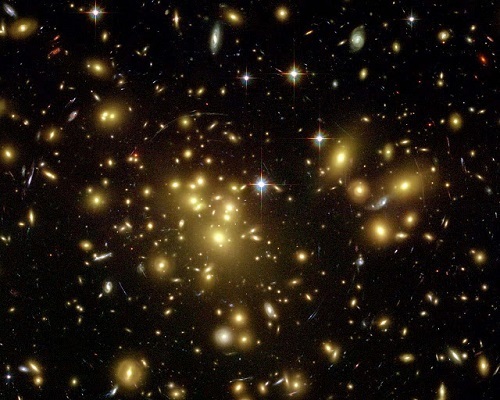
Image: The galaxy cluster Abell 1689, as seen from NASA’s Hubble Space Telescope. Faced with such immensity, what role do we assign intelligence in the ultimate fate of the universe? Credit: AFP/NASA.
The Price of Purpose
What Michaud calls cosmic humanism is not without its detractors, whose case emerges on practical grounds, and the author is wise to present it in the context of his larger argument. Anyone involved with the space community is challenged to explain why we should be looking beyond the Earth when we have so many problems here. Zero-sum arguments suggest that money spent on space is money taken away from social programs, leaving space advocates to argue the technological benefits that have accrued from the space program and future savings in areas like power generation.
These are arguments the space community has to be prepared to engage in with tangible benefits and a sensible eye toward budget realities. The moral argument can be trickier, and it also becomes ideological. Is space expansion just another way of imposing human chauvinism or preserving a Western model of industrial growth, a kind of futuristic ‘manifest destiny’? Is it in fact a thinly cloaked imperialism that turns the conflict of nation states into a model for future human conflict on other worlds, perhaps imposing our values on alien cultures?
We also run into the issue of limits. Michaud cites Philip Morrison, who has criticized the idea that there is any imperative for human expansion, arguing that as finite beings, we should be more attuned to our own limits. Added to this is the understandable argument that we have evolved in a biosphere for which we are now uniquely suited, and that expansion to other worlds would dilute and transform the species. Whether this is something to be deplored or celebrated is controversial, but certainly Michaud falls into line with Freeman Dyson as seeing diversification in society and ultimately biology as inevitable outcomes of an interstellar culture.
Behind all these objections lies the undeniable fact that a wide range of futures is within the realm of human choice, a philosophical stance varying from bounded to unbounded, a closed model vs. one open to expansion. Michaud points out that the window of opportunity for making a choice for the extraterrestrial paradigm is not necessarily infinite. We may run into serious issues of resource depletion within the next century that stymie our hopes for expansion.
Whether we take these outward steps depends on our motivations, on the values of our most powerful societies, and on political events within and between them. One might argue that, without an external goal, the world’s nations may have no purpose other than the periodic redistribution of wealth, status and power, often by force. By pointing out the promise of an extraterrestrial future, one might strengthen the case for solving current problems so that such a future can be realized.
Evolution of an Extraterrestrial Ethos
We cannot know what our species will ultimately choose, or whether natural or self-inflicted disaster will punctuate or even end future attempts at expansion into space. But what if our own extraterrestrial paradigm runs into the paradigm of another species? We may encounter, in the distant future, intelligent species that have chosen for their own reasons not to expand, perhaps through a lack of nearby destinations and resources or because of cultural values incompatible with colonizing other worlds. Or we may find expansionist beings whose interest is in shaping the universe to their own design to form a noosphere of interstellar dimension.
Here we can see Michaud the diplomat at work, asking how we might handle inevitable questions of contact and cooperation. Would the need for survival of a single species lead to conflict between it and the newly discovered others, a Darwinian struggle that could produce permanent limits to growth? We will need to be thinking about such issues down the road if interstellar travel ever becomes a reality, for ultimately we will be called upon to make ethical decisions — the hard currency of intelligence — involving both survival and altruism.
For intelligence to survive, shared purpose will need to come to the fore in our dealings with other civilizations, with an emerging macro-intelligence being made up of the individual contributions of cultures in control of their local sphere of space. Such a ‘conscious universe’ gives itself purpose through its own survival and the effort to impose structure and meaning upon the cosmos. If intelligence is to have a long-term purpose, something like this may be it.
Lighting the Cosmos
And if we are alone in the universe? Just as I was thinking about these issues yesterday I ran across Vinton Cerf’s What If It’s Us?, a short essay on the Communications of the ACM website. Cerf will be known to Centauri Dreams readers and almost all digitally aware people as the father of the TCP/IP protocols that are at the heart of the Internet. He’s also fascinated with the human future in space, and when I read his new piece, I found a useful synergy with what Michael Michaud is saying in “The Extraterrestrial Paradigm.”
Cerf was at a conference held by the Internet Society to discuss the emerging protocols for interplanetary communication when guest speaker David Brin asked what we would do if there were no other civilizations out there. What if we are the ones who are supposed to light the galaxy? If our species is destined to bring intelligence into at least the local cosmos and, in Michaud’s terms, impose choice on inevitability, just think of the responsibility that places upon us. Do we have the capacity as a species to survive long enough to make it happen? Cerf’s thought echoes Michaud:
I cannot speak for anyone else, but I think I would think somewhat differently about a lot of things. I would be thinking more long-term and be worried about the sustainability of our planet and the species that inhabit it. I would wonder what we should be developing to fulfill this mission. What technologies do we need to expand beyond our planet and our solar system? How should we prepare ourselves for such an ultimate goal?
Either way, you see, we face the need for sustained vision and developing purpose, our choices governing the outcome either here on among the stars. We must be prepared, as Michaud explains, to impose that purpose on a cosmos in which intelligence is rare just as we are prepared for possible contact with other species whose ideas on these matters may differ. Culturally, developing an outward-looking paradigm is not the work of years or decades but of centuries, requiring sustained effort and continuing debate. Those who choose to ponder these things on the public stage are playing a valuable role in the evolution of human purpose. They are helping us create the interstellar mission statement that will guide our way forward.






March 3, 2014
Toward an Extraterrestrial Paradigm
Growing up in the Sputnik era, I followed the fortunes of space exploration with huge enthusiasm. In those days, the model was primarily planetary in nature, the progression from the Moon to the nearest planets and then beyond seemingly inevitable. At the same time, a second model was developing around the idea of space stations and self-contained worlds built by man, one that would reach high visibility in the works of Gerard O’Neill, but one that ultimately reached back as far as the 1920’s (Oberth and Noordung) and further back to the science fiction of Jules Verne. In fact, E. E. Hale’s “The Brick Moon” explored a space station as early as 1869.
But even as our Mariners and Veneras explored other planets, an interstellar thread was also emerging. Robert Goddard wrote about interstellar journeys in 1918, science fiction was full of such travel as the field matured in the 1940s and ‘50s, and serious scientific study of interstellar flight became established by mid-century. Writing in 1979, Michael Michaud could point to Project Daedalus as the first serious starship design, and could note the continuing work of Robert Forward in presenting what he thought of as a roadmap for interstellar expansion.
Reasons for the Journey
It’s useful to frame these issues by seeing how they have been examined in the past, for if we are beginning to adapt to what Michaud calls an ‘extraterrestrial paradigm,’ it is because we have, in reaction to technological breakthroughs and exploration, been forced to adjust our ideas about our place in the cosmos. Michaud’s “The Extraterrestrial Paradigm: Improving the Prospects for Life in the Universe” pulls together his own prior work in the Journal of the British Interplanetary Society and the thinking of the scientists and scholars of the day to make the case for a human culture that will expand to the stars out of choices made in the service of a newly emerging sense of purpose.
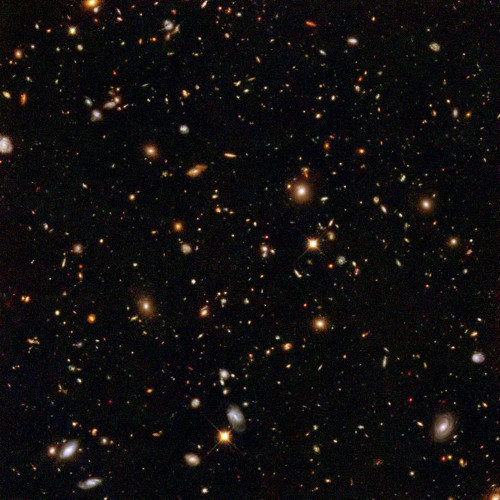
Image: Aswarm with galaxies, this part of the Hubble Ultra Deep Field survey cuts across billions of light-years. Such glimpses of immensity make us ponder the purpose behind human exploration of the cosmos. Credit: NASA, ESA, and R. Thompson (Univ. Arizona).
Solving the riddle of purpose must underlie all our explorations. Why, after all, do we choose to go into space in the first place? Robert Jastrow could find meaning in the linkage between cosmology and the workings of evolution, believing that persistent struggle and striving gave purpose to our existence. Michaud looks toward the loss of energy and structure we call entropy and asks whether life and the intelligence that can grow out of it are the only chance to reverse entropy on a local scale, and in his memorable phrase, “to impose choice on inevitability.”
Michaud’s essay deserves a wider audience, published originally in the academic journal Interdisciplinary Science Reviews and unavailable online. For the choices we make going forward are going to be continuous, given the decades- and probably centuries-long commitment that reaching the stars will require. But the extraterrestrial paradigm begins right here in our own system as we adapt our philosophy and perhaps one day our biology to moving off-planet. And while we have made the case for exploration and scientific research in spaceflight all along, Michaud here explores social and economic issues and the long term survival of the species as key drivers for the development of this new framework.
Expanding the economy beyond Earth’s limits allows us to surmount huge issues of resource depletion on the home world while developing new industrial processes in space. Earth’s energy demands can be met by abundant solar energy at the same time that we expand the human ecosphere to create new habitats beyond the Earth, perhaps modifying existing habitats through terraforming or other means. Moreover, the creation of a multitude of separate biospheres ensures us against collective disaster, whether natural or man-made. In terms of human liberty, freedom is enhanced and diversity encouraged as we experiment with new societies separate from those on Earth. All of these work together in shaping the extraterrestrial paradigm.
Centauri Dreams readers will be familiar with Michaud’s work in these pages, and also with his long-term commitment to developing a strategy for human expansion to the stars. His JBIS work in the late 1970s — three papers collectively known as “Spaceflight, Colonization and Independence: A Synthesis,” drawn on heavily in this essay — extends the colonization and humanization of the Solar System to an outward push to other star systems, one that by its nature changes who we are as we make the choice of who to become.
A New Cosmic Humanism
For humans, Michaud believes, must create their own goals in the absence of a pre-determined purpose imposed on them. The future, on this planet or elsewhere, depends on an evolutionary paradigm that relies on technology as a way to extend human influence into larger environments. It’s a view that suggests an inevitability about the rise of life and intelligence, but this determinism is modulated by chance as well as individual and social choice. That choice offers us the opportunity to bring meaning into the cosmos. As Michaud puts it:
The extraterrestrial paradigm suggests such goals: endless growth, expansion and discovery, the enrichment and rediversification of the species, and the increasing of human knowledge and power in the universe. Extraterrestrial growth could be a grand shared enterprise for humanity. It would define Homo sapiens by contrast with the external environment into which we ventured, and by contrast with nonexpanding forms of life and possibly intelligence on Earth. It suggests a way to free humans of Darwinian competition among themselves.
Above all, Michaud believes that the development of the extraterrestrial outlook helps us create a purposeful place for ourselves in the greater cosmos:
It suggests that, by our own activities, we can ensure the survival of our species, our intelligence, our consciousness, our culture, and that we can make intelligence have an impact on an inanimate, unfeeling universe, giving at least part of it an intelligent purpose. Thus the extraterrestrial paradigm may be an essential part of building a new cosmic context for mankind. It could be the basis for a sort of cosmic humanism that might be a factor in the philosophical history of the future.
Survival of the species demands short-term practical thinking but also the development of shared, long-term purpose, the latter more distant in time and requiring consensus and commitment. It may be that our movement into space expresses that purpose. But there are numerous challenges to the notion, all of which Michaud addresses in his essay. Tomorrow I’ll run through objections to this cosmic context, and go on to discuss how SETI comes into play. What happens to our own sense of purpose if and when we run into another intelligence?
The paper is Michaud, “The Extraterrestrial Paradigm: Improving the Prospects for Life in the Universe,” Interdisciplinary Science Reviews Vol. 4, No. 3 (1979), pp. 177-192. Michaud’s three-part study “Spaceflight, Colonization and Independence: A Synthesis” appeared in JBIS 30, 83-95 (Part I, March 1977); 203-212 (Part II, June 1977); 323-331 (Part III, September 1977).






February 28, 2014
‘Super-Earths’ Problematic for Life
The Kepler announcements yesterday were greatly cheering to those of us fascinated with the sheer process of doing exoplanetology. The ‘verification by multiplicity’ technique propelled the statistical analysis that resulted in 715 newly verified worlds, and we have yet to turn it loose on two more years of Kepler data (check Hugh Osborn’s excellent Lost in Transits site for more on the method). For those who focus primarily on habitable worlds, the results seemed a bit more sparse, with just four planets found in the habitable zone. And even where we find such, there are reasons to wonder whether a ‘super-Earth’ could actually sustain life.
Apropos of this question, a team of researchers led by Helmut Lammer (Austrian Academy of Sciences) has just published the results of its modeling of planetary cores, looking at the rate of hydrogen capture and removal for cores between 0.1 and 5 times the mass of the Earth found in the habitable zone of a G-class star. Cores like these inevitably attract hydrogen from the surrounding protoplanetary disk, although some of it will be stripped away by ultraviolet light from the hot young star they orbit. The question is, can enough of this primordial hydrogen envelope be blown off to allow the formation of a more benign secondary atmosphere?
The results are not promising for even relatively small super-Earths. Planetary cores with a mass similar to the Earth capture a hydrogen envelope and can also lose it — the paper suggests that terrestrial planets like Mercury, Venus, Earth and Mars lost their proto-atmospheres because of ultraviolet light. But high-mass cores similar to many of the super-Earth discoveries like Kepler-62e and -62f, wind up with atmospheres much thicker than ours. The habitable zone isn’t enough to guarantee a habitable world, as Lammer notes:
“Our results suggest that worlds like these two super-Earths may have captured the equivalent of between 100 and 1000 times the hydrogen in the Earth’s oceans, but may only lose a few percent of it over their lifetime. With such thick atmospheres, the pressure on the surfaces will be huge, making it almost impossible for life to exist.”
Image: The mass of the initial rocky core determines whether the final planet is potentially habitable. On the top row of the diagram, the core has a mass of more than 1.5 times that of the Earth. The result is that it holds on to a thick atmosphere of hydrogen (H), deuterium (H2) and helium (He). The lower row shows the evolution of a smaller mass core, between 0.5 and 1.5 times the mass of the Earth. It holds on to far less of the lighter gases, making it much more likely to develop an atmosphere suitable for life. Credit: NASA / H. Lammer.
The constraints here get to be pretty tight. Let me quote the paper on this:
Therefore we suggest that ‘rocky’ habitable terrestrial planets, which can lose their nebula-captured hydrogen envelopes and can keep their outgassed or impact delivered secondary atmospheres in habitable zones of G-type stars, have most likely core masses with 1±0.5M⊕ and corresponding radii between 0.8–1.15R⊕. Depending on nebula conditions, the formation scenarios, and the nebula life time, there may be some planets with masses that are larger than 1.5M⊕ and lost their protoatmospheres, but these objects may represent a minority compared to planets in the Earth-mass domain.
The super-Earths we’re likely to find in habitable zones, according to this work, are going to be uninhabitable places with hydrogen dominated atmospheres. The paper goes on to note that, based on its results, there may well be Earth-size and mass planets that have not been able to shed their captured, nebula-based hydrogen envelope. The upshot: Extreme caution is advised when speculating about how habitable planets evolve, particular when mass and density are still problematic. The variety of outcomes is wide even for small worlds inside the habitable zone.
The paper is Lammer et al., “Origin and Loss of nebula-captured hydrogen envelopes from “sub”- to “super-Earths” in the habitable zone of Sun-like stars,” accepted at Monthly Notices of the Royal Astronomical Society (preprint).






February 27, 2014
Kepler: Opening the Planet Verification Bottleneck
A planet like Kepler-296f is bound to get a lot of publicity. Orbiting a star half the Sun’s size and only five percent as bright, this world, twice the size of the Earth, appears to orbit in the habitable zone, where liquid water could exist on its surface. We focus so much on the potential of life that the four planets announced yesterday (out of 715 newly verified worlds) inevitably get special treatment. And we learn that Kepler-296f exists in a system with four other planets, orbiting the star every thirty days. What we don’t know is whether we’re dealing with a small Neptune-class world surrounded by a thick hydrogen/helium atmosphere or a water world with a deep ocean.
An interesting world, to be sure, but the real story in yesterday’s announcements from the Kepler team has to do with the ‘verification by multiplicity’ technique used to validate the existence of so many planets in 305 star systems. One of the findings papers titled “Almost All of Kepler’s Multiple Planet Candidates are Planets” (to be published March 10 in The Astrophysical Journal) makes the case that the vast majority of Kepler’s multiple planet candidates are true multi-planet systems, the number of false positives lower for multiples than for single detections. The paper continues (internal citations removed for brevity):
Kepler has found far more multiple candidate systems than would be the case if candidates were randomly distributed among target stars. False positives are expected to be nearly randomly distributed among Kepler targets, whereas true transiting planets could be clustered if planets whose sizes and periods are adequate for transits to be detected often come in multiples, as is the case for planets detected by radial velocity variations, and/or if planetary systems tend to be flat, so geometry leads to higher transit probabilities for other planets if one planet is seen to transit.
The paper gives a blow by blow description of the statistical analysis used here, but for our purposes, Kepler looked at over 150,000 stars and found only a few thousand that showed the characteristic lightcurve of a planetary transit. If this transit-like pattern were random, only a few stars would have shown more than one pattern, but we find hundreds of stars that have multiple transit-like patterns. As Jack Lissauer (NASA Ames) pointed out in yesterday’s teleconference, multiplicity is not random. Instead, it is a technique for opening up what Lissauer calls the ‘planetary verification bottleneck.’ Joining Lissauer in the teleconference were Jason Rowe (SETI Institute), Douglas Hudgins (NASA Astrophysics Division), and Sara Seager (MIT).
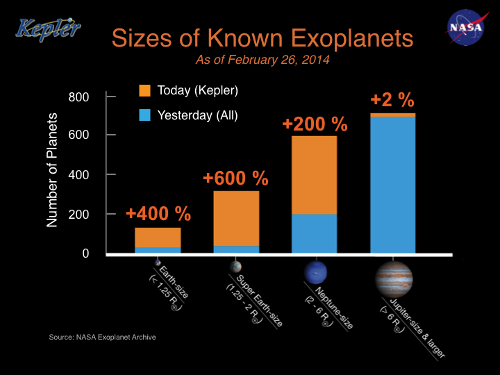
Image: The histogram shows the number of planets by size for all known exoplanets. The blue bars on the histogram represents all the exoplanets known, by size, before the Kepler Planet Bonanza announcement on Feb. 26, 2014. The gold bars on the histogram represent Kepler’s newly-verified planets. Image Credit: NASA Ames/W Stenzel.
Lissauer talks about the method as a way ‘to verify multiple planet candidates in bulk to deliver planets wholesale,’ and it yields 715 worlds of which 94 percent are smaller than Neptune, in the process establishing that multiple planet systems around a single star are common. The number of confirmed exoplanets now nears 1700. Besides Kepler-296f, three other verified worlds are less than 2.5 times the size of Earth and orbiting in their star’s habitable zone.
Overall, these results offer the largest number of validated planets ever to be announced at one time, a number sufficient for the transit technique to overtake radial velocity as the most prolific technique for exoplanet detection. And as Jason Rowe pointed out, these results show us small planets in multiple planet systems that move in circular, flat orbits, a configuration not unlike what we find in our own inner Solar System. “The more we explore,” Rowe added, “the more we find familiar traces of ourselves amongst the stars that remind us of home.”
The paper cited above is Lissauer et al. “Almost All of Kepler’s Multiple Planet Candidates Are Planets,” in press at The Astrophysical Journal (preprint). See also Rowe et al. “Validation of Kepler’s Multiple Planet Candidates. III: Light Curve Analysis & Announcement of Hundreds of New Multi-planet Systems,” also in press at The Astrophysical Journal (preprint). The archived Kepler media teleconference can be accessed here.






Paul Gilster's Blog
- Paul Gilster's profile
- 7 followers


